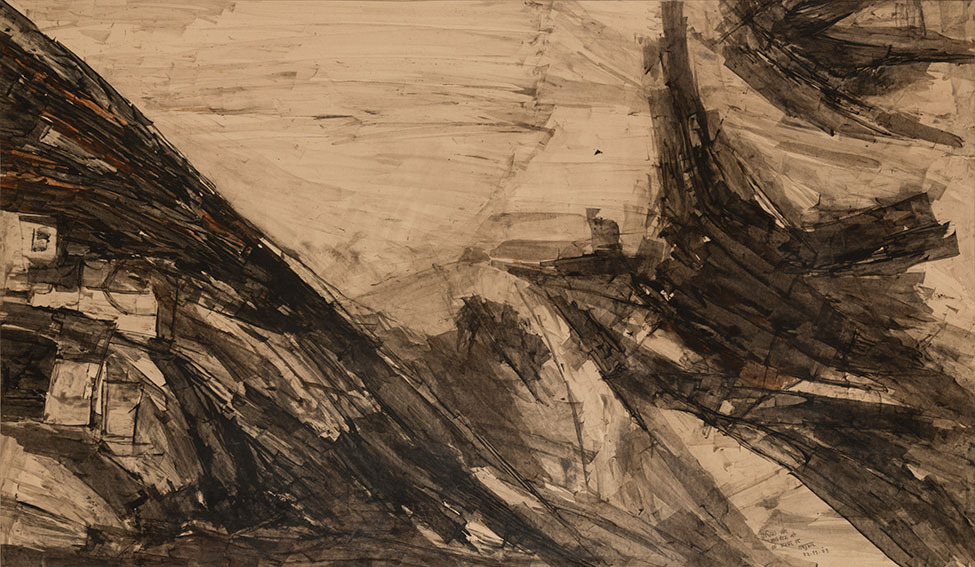Blogs
The Spirit of Creation
Georgina Maddox
Jagdish Swaminathan was instrumental in bringing folk and tribal art from the mud huts of rural India to the living rooms of its busy cities – two of them being Gond-Pardhan artist Jangarh Singh Shyam and Bhil artist Bhuri Bai. But who was Swaminathan and what was his significance?
Jagdish Swaminathan (1928–1994) was an artist who was instrumental not just in painting some of the most meditative yet minimal canvases during his journey as an artist, but also in mentoring and nurturing many artists, whether they adopted a Modernist approach or they referred to the rich lexicon of indigenous painting, which is largely known as folk and tribal art.
He mentored artists like Jangarh Singh Shyam and Bhuri Bai, writing about their work as well as spending personal time encouraging and supporting them. “Jangarh brings a vibrance and a luminosity to his work all his own. There is a great power and promise in the work of this young artist,” he once wrote for a catalogue of an exhibition hosted by Dhoomimal Art Gallery, in 1984.
Born in Shimla, and educated at the Delhi Polytechnic, and later in Warsaw, Poland, Swaminathan spent his early days as a journalist and art critic for a magazine, that was a project of the Communist Party of India, of which he was a member, until the mid-1950s. After that, Swaminathan decided to become a full-time artist, and with a group of other artists, he founded Group 1890. The group’s manifesto was based on Swaminathan’s ideology which attacked “vulgar naturalism,” the “idealism” of the Bengal School, and the “hybrid mannerism” of European Modernism; they preferred and urged other artists to see the “wonder” in their indigenous state.
An important and alternative voice in the Post-Independent Indian art scene, Group 1890 originally consisted of 12 artists, founder J. Swaminathan, Gulammohammed Sheikh, Himmat Shah, Jeram Patel, Ambadas, Jyoti Bhatt, Raghav Kaneria, Reddappa Naidu, Rajesh Mehra, Eric Bowen, S. G. Nikam and Balkrishna Patel and was incidentally named after the number of the house of J. Pandya, where the artists gathered and drafted their manifesto that has affected generations of painters.
They had its first and last show in 1963, that was inaugurated by the country’s Prime Minister at the time, Jawaharlal Nehru. They continued to meet and exchange ideas in smaller sub-groups. Though short lived, the individual efforts of its members had a profound impact and it gave fresh direction to Indian modernism. Those such as J. Swaminathan, Gulammohammed Sheikh, Jeram Patel, Jyoti Bhatt and the sculptors Himmat Shah and Raghav Kaneria, with their widely diverse oeuvres and artistic concerns, formed a very important concern for Indian Modernism and subsequently still impacts many of our contemporary artists till date.
Swaminathan was instrumental in the establishment of the Bharat Bhawan, a multi—art complex in Bhopal, in 1982. He also served as the director of its Roopankar Art Museum till 1990.It was at Bharat Bhavan where Swaminathan spotted an artist in Bhuri Bai, who is now considered a renowned contemporary artist and internationally recognised practitioner of the Bhil folk art form.
Swaminathan believed in the Nehruvian ideal of supporting and encouraging indigenous artists exposing their practice and ouvre to international audiences. Through his work as a writer and exhibition maker at Bharat Bhavan he gave filip to artists like Shyam and Bhuri Bai creating a platform for their art to be viewed by a larger audience and collected by international art patrons. In the instance of Jangarh Singh Shyam international travel proved to be a double-edged sword, but for others like Bhuri Bai the exposure has been beneficial.
Their influence on him is also noted when in the 1990s, Swaminathan broke away from his earlier ‘European style’ of geometric paintings with a brush or on an easel, and he began to explore the use of symbols in tribal art, and applied pigments with his fingers as a way to achieve a desired effect, notably also a ‘tribal art’ approach. He submerged himself in the lexicon of the tribal artists but brought his own modernist interpretations to it.
Throughout his career, Swaminathan held about 30 solo exhibitions and participated in numerous national and international exhibitions, before he passed away in 1994.
Georgina Maddox is a critic curator, based in Delhi who has been writing on art and culture for over two decades.








